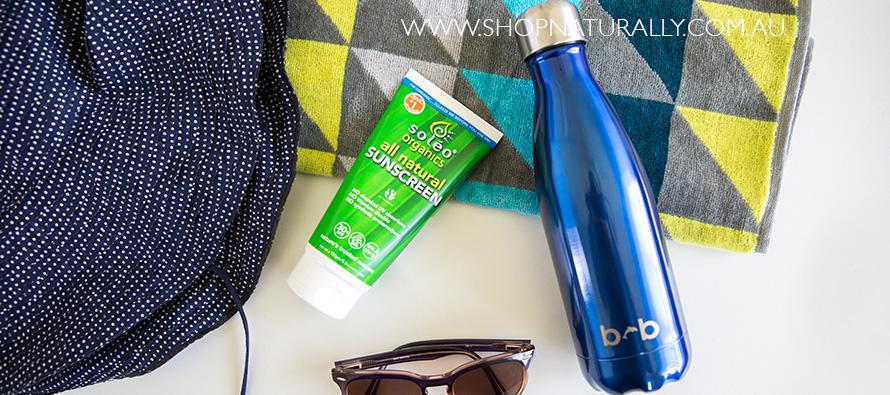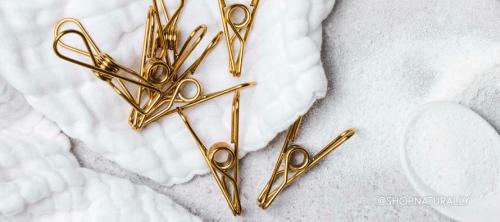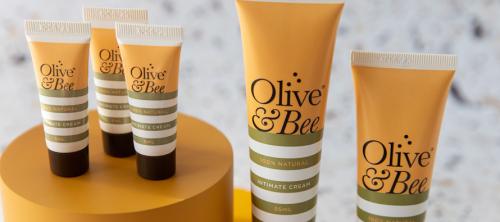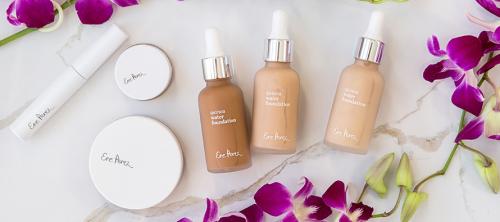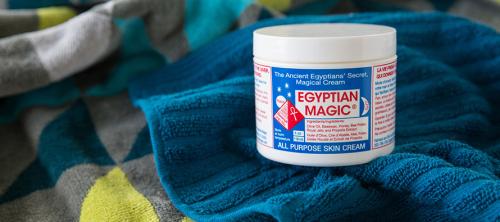Natural Sunscreen Nano Particle Safety FAQ
Since Australian organisation Friends Of The Earth removed their safe sunscreen guide from the web in 2012, there has been much speculation about the safety of the zinc oxide used in natural sunscreen formulas. Is it nano-free? Does it contain nano-particles? Are they safe? Are they dangerous? With the weather warming up, we decided to answer the most commonly asked questions from our customers to help you make an informed choice and the safest choice for your family.

What's the difference between the natural sunscreen on our shelves and what you buy in the supermarket or local chemist?
There are two types of sunscreen, a CHEMICAL sunscreen that is formulated to absorb UV rays and a MINERAL sunscreen that is formulated to create a physical barrier on the skin and reflect the UV rays away from your skin. We sell MINERAL sunscreen and will be referring to it as either NATURAL SUNSCREEN or MINERAL SUNSCREEN through the article.
The active ingredient in MINERAL sunscreen is usually zinc oxide or titanium dioxide. The CHEMICAL sunscreens contain a variety of ingredients that are listed with the EWG with hazard scores up to 8 out of 10. Read their article HERE rating the chemical blockers and their potential issues.
Let me make something really clear, we are NOT going to tell you that using sunscreen is dangerous. If you're going to be out in the sun for longer than around 20 minutes in the heat of the day (for the average person), you should cover up with something. Either clothing, a hat or some sunscreen. Whether you choose a mineral sunscreen or a chemical sunscreen is completely up to you. We're not here to scare, bully or manipulate. We're here to provide you with information so you can make an informed choice. There are pro's and con's to using both which we will outlay further on in this article.
Does my mineral sunscreen contain nano-particles? Is it safe?
This is where things get tricky. It may do. And that's ok. Keep reading though. You're about to learn something and it will take some of the sting out of the 'fear factor' surrounding this topic. There are no clear guidelines in Australia on what constitutes a nano-particle, how to test for it consistently, and how many are nano-particles in a 'non-nano' formula are still considered to be acceptable. If there was, Friends Of The Earth would have republished their guide and we could give you definitive information.
The following information comes from the Australian Journal of Pharmacy, Dec 2016 edition:-
"According to both the Royal Australian College of General Practitioiners (RACGP) and the Australasian College of Dermatologists, the general message is that the likelihood of harm from the use of sunscreens containing nanoparticles is low; sunscreens have been proven to reduce rates of non-melanoma and melanoma skin cancers; thus, their use in prevention should be encouraged."
Choice Magazine in Australia wrote their article on the subject in 2014 and it's worth the read (HERE). In part, it says:-
"Studies using both animal and human skin have shown that nanoparticles do not penetrate the underlying layers of skin, with penetration limited to the outermost layer of the skin. This suggests that systemic absorption is unlikely."
-and-
"... in the event that they do get into the bloodstream (for zinc oxide at least), the body's immune system can deal with them effectively."
-and-
"The overall conclusion is that there's no known health risk from these nanoparticles and you can safely use sunscreens that contain them."
-and their final verdict-
"The weight of evidence is clear. There's more risk from not using sunscreen than there is from using it, whether or not it contains nanoparticles. Not using sunscreen can increase your risk of skin cancer, while using it may result in nanoparticles sitting on the surface of your skin (helping to protect you from UV radiation), but they aren't absorbed into your body. Nevertheless, consumers should still be able to choose nano-free sunscreens if they want, and we want products containing nanoparticles to be labelled accordingly."

How effective is natural sunscreen?
It's great if you apply it properly. It is a little harder to rub in than chemical sunscreen and you need to treat it as such in order for it to provide you effective coverage. In Australia, the use of SPF ratings on sunscreen is highly regulated by the TGA. If it is for sale in Australia, the TGA have tested it and it complies with their regulations. You must ensure you apply natural sunscreen correctly or it may not be as effective as it should be.
- Be generous - you're providing a physical barrier on your skin to reflect the suns rays. If you use it sparingly, the coverage will be patchy and ineffective. If you use the same amount as a chemical sunscreen and you don't give proper coverage, or you give a thin coverage, you're going to burn quicker.
- Rub it in evenly - depending on the brand, this can take some extra time. Any of the formulas that are a little on the oily side can take some extra time to rub in. Take the time to do it properly. If you're going to 'slip slop slap' and not rub it in properly, expect patchy results.
- Apply at least 20 minutes before going out in the sun - this is the same advice for all sunscreen.
- Reapply every 2 hours or after sweating or swimming or towel drying - you are forming a physical barrier on the skin and it can deteriorate over time, with water or with rubbing.
Repeat after me, using sunscreen (natural or otherwise) is NOT a licence to stay out in the sun all day and not burn. Sunscreen slows down the rate at which your skin will burn. Some people with fair skin burn considerably quicker than those with olive skin. Age can be a factor, as can ethnicity. I am blessed with Italian heritage and olive skin. Our warehouse manager is pale and burns very quickly. Using the same sunscreen provides different results for the both of us.
So, the main factors in determining how well your natural sunscreen works are:-
- How much did you apply
- How evenly did you rub it in
- How well did you rub it in
- Do you burn easily
- Did you do anything to effect the barrier you created on your skin, and if so, reapply
Bottom line, if you expect the same application and results as a chemical sunscreen, you're going to run in to some issues. Apply it correctly and you'll find it's just as effective, it not, more effective than a chemical sunscreen. Apply it poorly, and you will get patchy results.
But natural sunscreen leaves a film or a white cast on my skin
Yes, it does. You're forming a physical barrier on the skin. If you need something to rub in completely, the best option is the Simple As That Sunscreen, newly formulated and released in 2016. Formulated by compounding pharmacist Danielle Glover from Toxin Free Living, it rubs in the best out of all the natural sunscreen choices we have. If you're going to be outside for extended periods of time and swimming, I would highly suggest putting it on a little thicker and allowing it to leave a white cast on your skin for a thicker barrier, but it does rub all the way in. You can see from our image below, we lathered it on and then only rubbed half in to show you the results. It took at least twice as long to rub in than a chemical sunscreen would.

Best natural sunscreen choice for sensitive skin
I'm going to make two recommendations here, for people who have sensitivities, or kids with sensitivities.
- The Simple As That Sunscreen we just mentioned above
- Soleo Organics Sunscreen
Why these two? Purely from my own personal experience and the personal experience of staff and customers who have given us feedback. Please, always patch test if you have issues.

Natural Sunscreen Oily to Dry Scale
One of the biggest issues we hear from customers is that they either find a particular natural sunscreen too oily or too dry. This depends on your skin type. Zinc Oxide can be drying on the skin, and since the sunscreens usually have around 20% of it in their formula, the other ingredients play a vital role in how your skin feels. We find many customers have either a love or hate relationship with Wotnot Sunscreen because it's a tad on the oily side. It's a lifesaver for some, an annoyance for others. Below is our guide to which end of the spectrum each sunscreen belongs. If you find mineral sunscreen really drying on your skin, head more toward the middle of the list or the oily end of the list. If you have troubles with oil on your skin, head further down to the dry spectrum.
OILIER END OF THE SPECTRUM
UV Natural
Wot Not
Eco Tan
Soleo Organics
Sitting perfectly in the middle is Simple As That
Eco Sunscreen
Little Innoscents
Natural Instinct
DRIER END OF THE SPECTRUM
What's the best budget friendly option?
Natural Instinct do a 200g tube for $25.95, which is the largest one available and the best value for money. We do have some great deals on for Summer 2016/2017 though, so be sure to check our whole range. Their tinted face sunscreen is also at an unbeatable price.
I'm swimming, what's the best water resistant natural sunscreen?
Soleo Organics or Eco Sunscreen are our pick. Please reapply frequently and keep an eye on your skin. Excessive rubbing of your skin or being tumbled around in the surf or sliding on and off surfboards call all effect a mineral sunscreen barrier. The new Simple As That Sunscreen has not been officially tested for water resistance, but our own trials showed it held up well if it was applied in a thicker layer.

What about the best natural sunscreen for my kids?
Wotnot is always a winner. It's a tad on the oily side, which suits most kids skin. Now the Simple As That Sunscreen joins the ranks as it's suitable for sensitive skin and ideal for kids. If you're letting your kids actually apply it and you're at the beach, the kids version of the Natural Instinct always leave a white barrier on the skin, so you can tell if they rubbed it in properly. You won't quite know with the other brands, and as you read above, careful and proper application is a must.
Best Face Sunscreen - untinted
The winner is Simple As That, closely followed by the Eco Sunscreen. The major difference is that the Simple As That rubs in just a little better and it doesn't have much of an aroma at all. The Eco Sunscreen Face has a little bit of a smell, but it fades after several minutes. Why do you need a dedicated face sunscreen? The added ingredients are more nourishing. Zinc oxide can be very drying on the skin. You can use a face sunscreen on your whole body if you wish. I actually do, as I have sensitive skin and I use the Simple As That all over.
Best Face Sunscreen - tinted
This is where we step over to dedicated natural skin care brands who shine. Andalou Naturals have BB and CC creams, tinted, with SPF 30 ratings. Some mineral powders found in our natural makeup section have an SPF rating of around 15 due to the mineral powders they contain, so they provide some coverage, but this is also affected by how thinly you apply, so I wouldn't rely on it for anything more than a little protection walking between meetings or short bursts of car travelling. If you're 'out' in the sun, I would use something more effective than a SPF mineral powder foundation.
Is coconut oil an effective sunscreen?
Nope. It has a really low natural SPF rating of about 4. Using coconut oil as a natural sunscreen is not very effective at all.
Is there any such thing as a certified organic sunscreen?
No. The percentage of zinc oxide needed in the formula is always higher than the certifying bodies allow for a non-organic ingredients. Zinc oxide is a mineral and cannot ever be certified organic. Organic sunscreen is a marketing myth. Many contain organic ingredients, but the formula as a whole cannot be certified.
Ingredient disclosure (or lack thereof)
Did you know that despite the TGA rules and regulations, sunscreen manufacturers are NOT required to list all the ingredients in the product in Australia? They are required to list the active ingredient, but nothing else. It makes it virtually impossible to find out what's in the vast majority of the chemical sunscreens. We disclose full ingredients lists on all our natural sunscreen.
*pictured in our top banner - water bottle (stainless steel & vacuum insulated - perfect for the beach) from Beautiful Beaches + Soleo Organics sunscreen.
